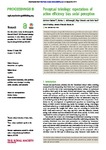Perceptual Teleology: Expectations of Action Efficiency Bias Social Perception
| dc.contributor.author | Bach, Patric | |
| dc.contributor.author | Hudson, Matthew | |
| dc.contributor.author | McDonough, Katrina | |
| dc.contributor.author | Edwards, R | |
| dc.date.accessioned | 2018-07-16T09:18:34Z | |
| dc.date.issued | 2018-08-15 | |
| dc.identifier.issn | 0962-8452 | |
| dc.identifier.issn | 1471-2954 | |
| dc.identifier.other | 20180638 | |
| dc.identifier.uri | http://hdl.handle.net/10026.1/11839 | |
| dc.description | No embargo required. | |
| dc.description.abstract |
<jats:p>Primates interpret conspecific behaviour as goal-directed and expect others to achieve goals by the most efficient means possible. While this teleological stance is prominent in evolutionary and developmental theories of social cognition, little is known about the underlying mechanisms. In predictive models of social cognition, a perceptual prediction of an ideal efficient trajectory would be generated from prior knowledge against which the observed action is evaluated, distorting the perception of unexpected inefficient actions. To test this, participants observed an actor reach for an object with a straight or arched trajectory on a touch screen. The actions were made efficient or inefficient by adding or removing an obstructing object. The action disappeared mid-trajectory and participants touched the last seen screen position of the hand. Judgements of inefficient actions were biased towards the efficient prediction (straight trajectories upward to avoid the obstruction, arched trajectories downward towards the target). These corrections increased when the obstruction's presence/absence was explicitly acknowledged, and when the efficient trajectory was explicitly predicted. Additional supplementary experiments demonstrated that these biases occur during ongoing visual perception and/or immediately after motion offset. The teleological stance is at least partly perceptual, providing an ideal reference trajectory against which actual behaviour is evaluated.</jats:p> | |
| dc.format.extent | 0-0 | |
| dc.format.medium | Electronic | |
| dc.language | en | |
| dc.language.iso | en | |
| dc.publisher | Royal Society, The | |
| dc.subject | representational momentum | |
| dc.subject | action prediction | |
| dc.subject | prediction errors | |
| dc.subject | teleological reasoning | |
| dc.subject | motion perception | |
| dc.subject | social perception | |
| dc.title | Perceptual Teleology: Expectations of Action Efficiency Bias Social Perception | |
| dc.type | journal-article | |
| dc.type | Journal Article | |
| dc.type | Research Support, Non-U.S. Gov't | |
| plymouth.author-url | https://www.webofscience.com/api/gateway?GWVersion=2&SrcApp=PARTNER_APP&SrcAuth=LinksAMR&KeyUT=WOS:000441725900003&DestLinkType=FullRecord&DestApp=ALL_WOS&UsrCustomerID=11bb513d99f797142bcfeffcc58ea008 | |
| plymouth.issue | 1884 | |
| plymouth.volume | 285 | |
| plymouth.publication-status | Published | |
| plymouth.journal | Proceedings of the Royal Society B: Biological Sciences | |
| dc.identifier.doi | 10.1098/rspb.2018.0638 | |
| plymouth.organisational-group | /Plymouth | |
| plymouth.organisational-group | /Plymouth/Faculty of Health | |
| plymouth.organisational-group | /Plymouth/Faculty of Health/School of Psychology | |
| plymouth.organisational-group | /Plymouth/REF 2021 Researchers by UoA | |
| plymouth.organisational-group | /Plymouth/REF 2021 Researchers by UoA/UoA04 Psychology, Psychiatry and Neuroscience | |
| plymouth.organisational-group | /Plymouth/Research Groups | |
| plymouth.organisational-group | /Plymouth/Research Groups/Centre for Brain, Cognition and Behaviour (CBCB) | |
| plymouth.organisational-group | /Plymouth/Research Groups/Centre for Brain, Cognition and Behaviour (CBCB)/Brain | |
| plymouth.organisational-group | /Plymouth/Users by role | |
| plymouth.organisational-group | /Plymouth/Users by role/Academics | |
| dc.publisher.place | England | |
| dcterms.dateAccepted | 2018-07-12 | |
| dc.rights.embargodate | 2019-11-26 | |
| dc.identifier.eissn | 1471-2954 | |
| dc.rights.embargoperiod | Not known | |
| rioxxterms.versionofrecord | 10.1098/rspb.2018.0638 | |
| rioxxterms.licenseref.uri | http://www.rioxx.net/licenses/all-rights-reserved | |
| rioxxterms.licenseref.startdate | 2018-08-15 | |
| rioxxterms.type | Journal Article/Review | |
| plymouth.funder | One step ahead: Prediction of other people's behavior in healthy and autistic individuals.::ESRC |


